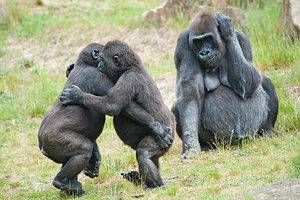Gorillas are beautiful animals of enormous size! They are easy to recognize as they thump their chests with muscular arms and grin to reveal huge canine teeth. These amazing creatures are very closely related to humans and demonstrate a high degree of cognition and sociality. Gorillas are the ultimate combination of brain and brawn! This article will explore the different gorilla subspecies and will reveal the world’s largest gorilla!
What is a gorilla?

An infant gorilla clings to its mother.
©Asaf Weizman/Shutterstock.com
Gorillas are primates and are closely related to humans! In fact, gorillas, chimpanzees, and humans diverged from a common ancestor around 7 million years ago. The taxonomic order Primates includes many species of lemurs, lorises, tarsiers, monkeys, and apes that live around the world. Gorillas are apes along with chimpanzees, bonobos, orangutans, gibbons, and humans. For more on the differences between monkeys and apes click here!
The genus Gorilla includes two species and four subspecies. The species Gorilla gorilla is the Western gorilla and includes two subspecies: the Western lowland gorilla (G. g. gorilla) and the Cross River gorilla (G. g. diehli). The second species of a gorilla is the Eastern gorilla, also known as Gorilla beringei. The two subspecies of eastern gorillas include the mountain gorilla (G. b. beringei) and the eastern lowland gorilla (G. b. graueri). Mountain gorillas are also popularly known as silverback gorillas. Genetic evidence suggests that the western and eastern gorilla species diverged around 261,000 years ago.
What are the largest gorilla subspecies?

An
eastern lowland gorilla
.
©PhotocechCZ/Shutterstock.com
The largest gorilla subspecies is the eastern lowland gorilla. The wild male eastern lowland gorilla typically weighs between 361 and 461 pounds! Gorillas are therefore the largest living primate. The other eastern gorilla subspecies, the mountain gorilla, weighs between 265 and 421 pounds. As for western gorilla subspecies, the Cross River gorilla and western lowland gorilla typically weigh between 310 and 440 pounds. Gorillas of all subspecies, however, can weigh substantially more in captivity.
How do gorillas compare to other primates?

The Cross River gorilla (shown) and the western lowland gorilla typically weigh 310-440 pounds.
©Kit Korzun/Shutterstock.com
Within the order of Primates, great apes include gorillas, chimpanzees, bonobos, orangutans, and humans. Gibbons are “lesser apes”. Gorillas, as the largest living primates, are the largest of the great apes by a substantial margin. Male orangutans are the next heaviest nonhuman ape weighing 165 pounds on average. Male chimpanzees have an average weight between 88 and 154 pounds, and bonobos on average weigh 99 pounds. Humans, however, are the second heaviest great ape with the average American man weighing 197.9 pounds.
In comparison to monkeys, gorillas are gigantic. The largest species of monkey is the mandrill. The male mandrill has a maximum weight of 119 pounds! This is huge among monkeys but relatively small among apes. A gorilla’s weight is equal to about four mandrills! The smallest species of monkey is the pygmy marmoset, which weighs 3.5 ounces. A gorilla’s weight is therefore equal to over 2,100 pygmy marmosets!
Why do gorillas get so big?
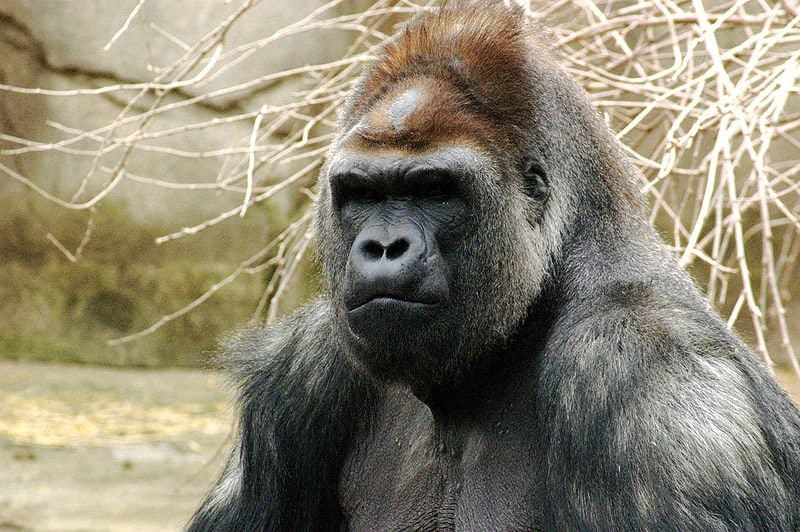
A male
western lowland gorilla
.
©Kabir Bakie / CC BY-SA 2.5, from Wikimedia Commons, the free media repository – License
A gorilla’s massive size has an evolutionary explanation. Gorillas exhibit a high degree of sexual dimorphism. Sexual dimorphism is when there is a substantial difference in appearance between males and females of the same species. In many bird species, for example, this presents colorful feathers in males and dull feathers in females, like peacocks and peahens. In many primate species, there is a substantial difference in size between the sexes. Sexual dimorphism is most often a product of sexual selection.
Sexual selection describes how one sex chooses an individual of the opposite sex based on preferred characteristics that suggest higher fitness. To continue with the peacock example, peacocks with the most colorful and most elaborate tailfeathers are superior mates over a peacock with duller tailfeathers. Elaborate, colorful feathers suggest a male is healthy, has access to resources, and is able to evade predators despite being so conspicuous. A female is more likely to mate with the most flamboyant male because they will produce the fittest offspring.
Although male gorillas don’t have colorful feathers, their incredible size compared to females is an example of sexual dimorphism. Large bodies and large canine teeth are the product of competition between males for access to females. Larger males exhibit greater fitness by dominating other males and as a result, have more reproductive opportunities. As larger males continue to have more offspring than smaller ones, over several generations the average size will increase.
What is the largest gorilla ever recorded?
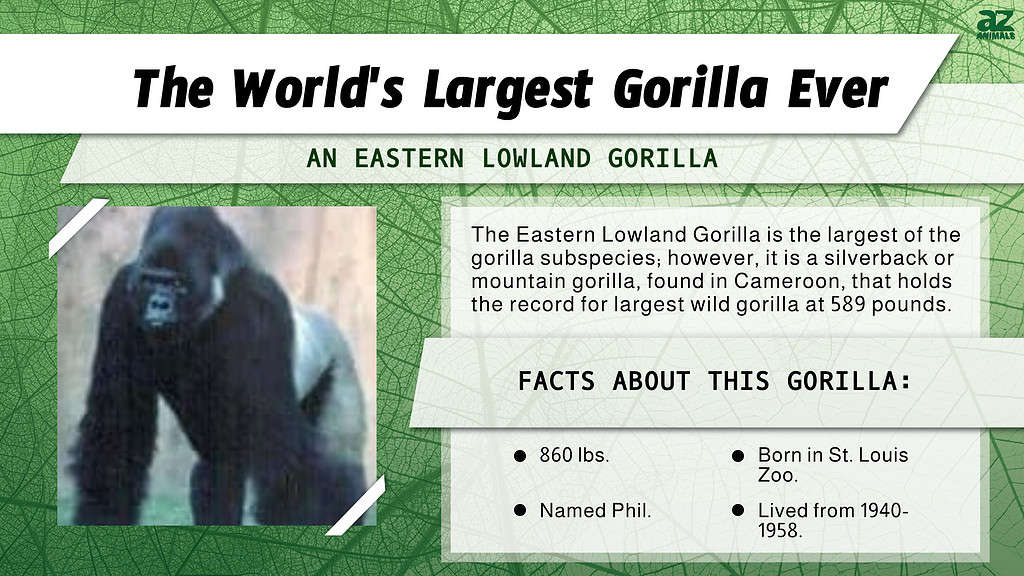
The largest gorilla ever recorded weighed a massive 860 pounds! This giant gorilla was an eastern lowland gorilla born in captivity at St. Louis Zoo. He was named Phil and lived from 1940-1958. Gorillas, and most animals in general, weigh substantially more when raised in captivity compared to those that live in the wild.
The largest wild gorilla on record is a male silverback or mountain gorilla that was hunted in Cameroon. This large gorilla weighed 589 pounds! That is about 40% larger than what is typical of that subspecies.
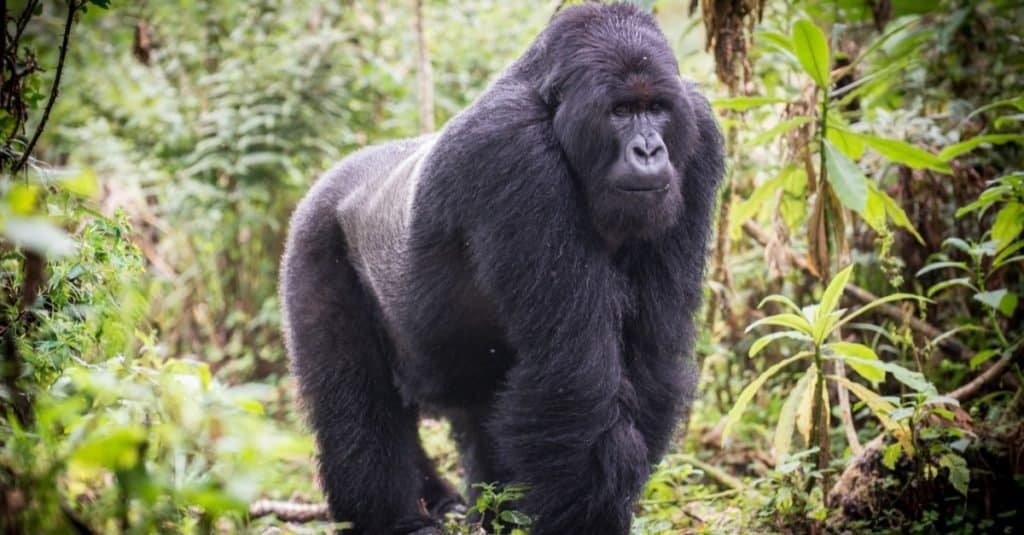
A male
silverback mountain gorilla
holds the record for largest gorilla found in the wild at 589 pounds.
©Jurgen Vogt/Shutterstock.com
How are gorillas doing today?
All subspecies of gorillas are in grave danger today. Mountain gorillas are listed as endangered on the IUCN red list. Western and eastern lowland gorillas, and Cross River gorillas are categorized as critically endangered. “Critically endangered” is the most severe status before extinction in the wild and total extinction. The western gorilla is more populous than the eastern gorilla, however, the number of individuals in the wild is very low.
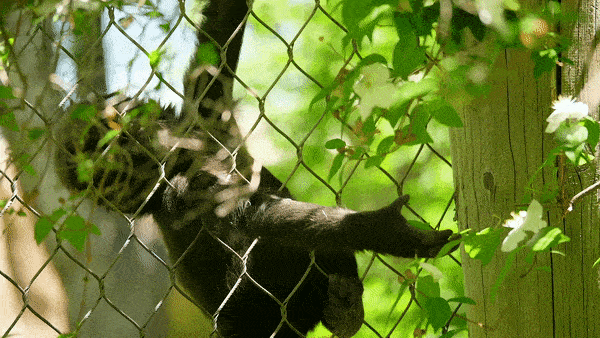
Gorillas are primarily threatened by poaching- being intentionally killed or unintentionally killed by traps set for other animals. Habitat destruction, disease, and war also have heavy effects on gorilla populations. In times of civil unrest, refugees have turned to bushmeat for sustenance, and gorillas, as well as other apes, have suffered as a result. Because gorillas are so closely related to humans, they can suffer from different diseases transmitted by humans. In 2004, Ebola ravaged gorillas in the Republic of Congo effectively eliminating the population there. Recent estimates suggest as many as 5,000 gorillas have died from Ebola.
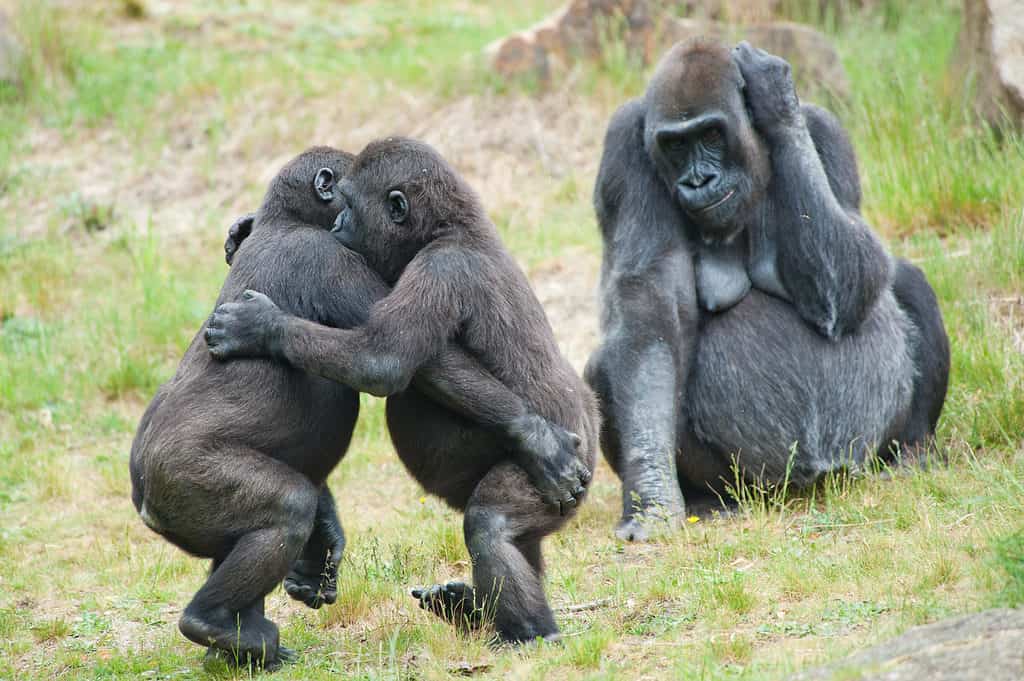
All gorillas are classified as either endangered or critically endangered.
©Eric Gevaert/Shutterstock.com
Different conservation efforts are in place that has had many positive impacts. There used to be fewer than 880 mountain gorillas alive, but in 2018 they were reclassified from critically endangered to endangered as their population grew past 1,000 individuals. Breeding programs in various zoos attempt to repopulate both species directly. Organizations and laws also exist to protect gorillas. The Great Apes Survival Partnership (GRASP) aims to conserve all nonhuman great apes including gorillas. Also, the Gorilla Agreement is legislation that targets gorilla conservation specifically.
Where do Gorillas Live?
Gorillas are native to Africa – the two species are separated by 560 miles of Congo Basin forest. Each has a lowland and a highland subspecies. The Western lowland gorilla is the most numerous with population estimates at 100,000 – 200,000. The least numerous is the cross river gorilla, which can only be found in scattered areas of forests in Nigeria and Cameroon and numbers no more than 300 individuals.
Gorillas are mainly herbivores and play a vital role in their environments in seed dispersal. Many large fruit trees depend on gorillas to survive. Adults can eat up to 30kg (66 lbs) of food each day – including bamboo, fruit, leafy plants, and small insects.
The photo featured at the top of this post is © iStock.com/SooniosPro
Thank you for reading! Have some feedback for us? Contact the AZ Animals editorial team.




